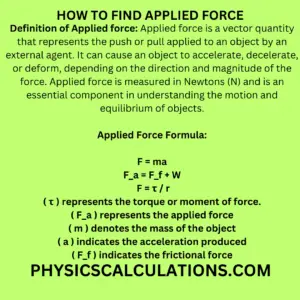Introduction
In the field of physics, the knowledge of how to find applied force is very important. Applied force refers to the external force acting upon an object, causing it to accelerate or deform. It is a fundamental concept in mechanics and plays a significant role in various real-world applications.
How to Find Applied Force: The basics
What is Applied Force?
Definition of Applied force: Applied force is a vector quantity that represents the push or pull applied to an object by an external agent. It can cause an object to accelerate, decelerate, or deform, depending on the direction and magnitude of the force. Applied force is measured in Newtons (N) and is an essential component in understanding the motion and equilibrium of objects.

Newton’s Second Law of Motion
To comprehend how to find applied force, it is crucial to grasp Newton’s Second Law of Motion. According to this law, the acceleration of an object is directly proportional to the net force acting on it and inversely proportional to its mass. The applied force formula which is generally represented by Newton’s second law of motion, relates force (F), mass (m), and acceleration (a), which is mathematically expressed as:
F = ma
Where:
- ( F ) represents the applied force
- ( m ) denotes the mass of the object
- ( a ) indicates the acceleration produced
By rearranging the formula, we can determine the applied force (F) by multiplying the mass (m) of an object by its acceleration (a).
How to Calculate Applied Force in Different Scenarios
Scenario 1: Finding Applied Force with Known Mass and Acceleration
In this scenario, if you are provided with the mass of an object and its acceleration, you can easily calculate the applied force using Newton’s Second Law of Motion. Let’s consider an example:
Problem 1:
Suppose a car with a mass of 1200 kg accelerates at a rate of 5 m/s². What is the applied force acting on the car?
To find the applied force, we can use the formula, F = ma. Substituting the given values:
F = ma = 1200 x 5 = 6000 N
Therefore, the applied force acting on the car is 6000 Newtons.
Scenario 2: Finding Applied Force with Known Weight and Friction
In certain scenarios, you may need to determine the applied force when the weight and frictional forces are known. Let’s explore this situation with an example:
Problem 2:
Consider a block with a weight of 200 N on a horizontal surface. The coefficient of friction between the block and the surface is 0.4. What is the applied force required to move the block?
To find the applied force, we need to consider the forces acting on the block. In this case, the gravitational force (weight) and the frictional force oppose the applied force. You can derive the equation to calculate the applied force as follows:
Fa = Ff + W
We can find the frictional force (Ff) by using the formula:
Frictional force (Ff) = Coefficient of static friction (μ) x Normal reaction (R)
Therefore
Ff = μ x R = 0.4 x 200 = 80 N
We can now calculate the applied force (Fa)
Fa = Ff + W = 80 N + 200 N = 280 N
Hence, the applied force required to to move the block is 280 Newtons.
Frequently Asked Questions (FAQs)
1: What are some real-life examples of applied force?
We come across applied force in many real-life scenarios. Some examples include:
- Pushing a car until it starts
- Pulling a door to open or close it
- Lifting weights at the gym
- Kicking a football during a game
2: Is applied force the same as normal force?
No, applied force and normal force are not the same. Normal force refers to the force exerted by a surface to support the weight of an object resting on it, perpendicular to the surface. Applied force, on the other hand, is the external force acting upon an object.
3: Can the applied force be negative?
Yes, the applied force can be negative. A negative applied force indicates that the force is acting in the opposite direction to the positive direction defined in a particular system.
4: How does friction affect the applied force?
Friction opposes the applied force, making it harder to move objects. The coefficient of friction determines the magnitude of the frictional force, and a higher coefficient of friction results in a larger opposing force.
5: Are there any formulas for calculating applied force in rotational motion?
Yes, in rotational motion, we can calculate applied force by using the formula:
τ = F x r
Where:
- ( τ ) represents the torque or moment of force.
- ( F ) denotes the applied force
- ( r ) indicates the radius or lever arm
Q6: What are the SI units for applied force?
The SI unit for applied force is the Newton (N).
Conclusion
In conclusion, the knowledge of how to find applied force is very important in the field of physics. Therefore, by applying Newton’s Second Law of Motion and considering various scenarios, you can calculate the applied force acting on objects in different situations.
Additionally, remember to consider factors such as mass, acceleration, weight, friction, and rotational motion when finding the applied force. With this comprehensive guide, you now possess the knowledge and tools to tackle problems related to applied force in physics.
You may also like to read: